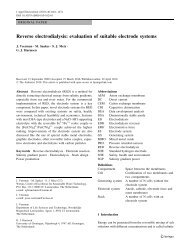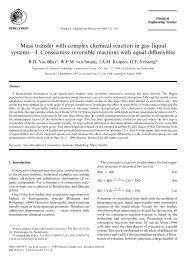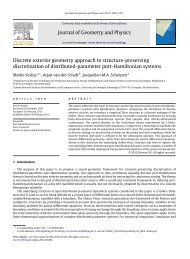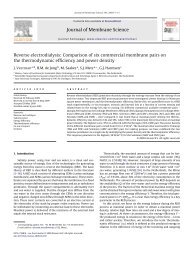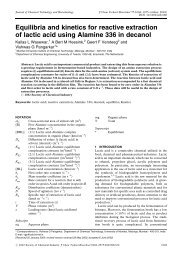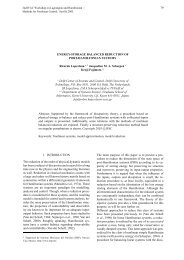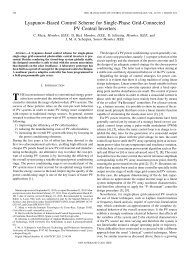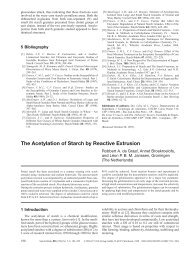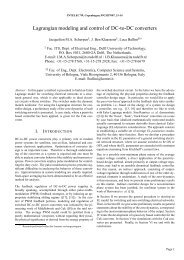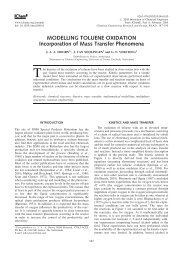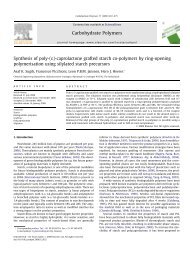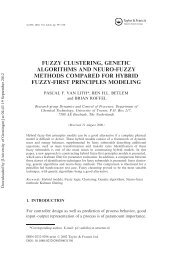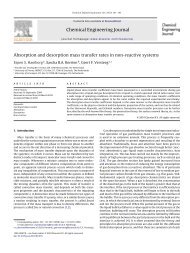Quantitative Analysis of Chemically Modified Starches by 1H ... - ITM
Quantitative Analysis of Chemically Modified Starches by 1H ... - ITM
Quantitative Analysis of Chemically Modified Starches by 1H ... - ITM
Create successful ePaper yourself
Turn your PDF publications into a flip-book with our unique Google optimized e-Paper software.
<strong>Quantitative</strong> <strong>Analysis</strong> <strong>of</strong> <strong>Chemically</strong><br />
<strong>Modified</strong> <strong>Starches</strong> <strong>by</strong> <strong>1H</strong>-NMR Spectroscopy<br />
A quantitative <strong>1H</strong>-NMR method for the determination <strong>of</strong> the Molar<br />
Substitution (MS) <strong>of</strong> acetylated and hydroxypropylated starches was<br />
developed and tested for MS ranging from 0.09 to 0.5. Results were<br />
checked using the Johnson method and a titration method for hydroxypropylated<br />
and acetylated starch, respectively. Hydroxypropylated<br />
starch was produced using both a static mixer reactor (SMX<br />
type) and a co-rotating twin screw extruder. Acetylated starch was<br />
produced using a counter-rotating twin screw extruder. <strong>Quantitative</strong><br />
analysis results <strong>of</strong>the IH-NMR method were in good agreement with<br />
traditional analysis methods for all sampies tested. Main advantage<br />
<strong>of</strong>the IH-NMR method is the considerable time saving as compared<br />
to the tradition al analysis methods.<br />
1 Introduction<br />
Nowadays, large quantities <strong>of</strong> chemically modified starches<br />
are used in industrial processes. Two important product<br />
groups are the starch ethers and the starch esters. In this study<br />
hydroxypropylated and acetylated starches were used.<br />
R.A. de Graaf, G. Lammers, L.P.B.M.<br />
Janssen, and A.A.C.M. Beenackers,<br />
Groningen (The Netherlands)<br />
<strong>Quantitative</strong> Analyse von chemisch modifizierten Stärken durch<br />
<strong>1H</strong>-NMR-Spektroskopie. Eine Bestimmungsmethode des Substitutionsgrades<br />
von acetylierter und hydroxypropylierter Stärke mittels <strong>1H</strong>-<br />
NMR auf molare Substitution (DS) von 0,09-0,05 wurde entwickelt.<br />
Die hydroxypropylierte Stärke wurde in einem Static-Mixer (SMX)<br />
und einem selbstreinigenden Doppelschnecken-Kneter hergestellt.<br />
Die acetylierten Stärken wurden in einem gegenläufigen engschließenden<br />
Doppelschnecken-Kneter gewonnen. Die hydroxyopropylierten<br />
Stärkeprodukte wurden mit der lohnson-Methode und durch IH_<br />
NMR analysiert. Die acetylierten Stärkeprodukte wurden durch Titration<br />
und IH-NMR untersucht. Beide Methoden erbrachten ähnliche<br />
Ergebnisse mit guter Korrelation.<br />
Starch is a mixture in variable proportions <strong>of</strong> the linear poly-<br />
(1,4)-a-D-glucan, amylose, and the branched moleeule, amylopectin,<br />
where linear (1,4)-a-D-glucan chains are connected<br />
through (1,6)-a-linkages (Blanshard) [1]. The alcohol groups<br />
on the anhydroglucose units <strong>of</strong> both polymers react under alkaline<br />
conditions with propylene oxide (Roberts) [2] or vi-<br />
starchlstärke 47 (1995) Nr. 12. S. 469-475 © veH Verlagsgesellschaft mbH, D-69451 Weinheim, 1995 0038-9056/95/1212-0469$05.00+.2510 469
nylacetate (Lammers et al.) [3]. This way, hydroxypropylated<br />
and acetylated starches are produced, respectively (Figure 1).<br />
The average number <strong>of</strong> substituents per D-glucose unit is<br />
given <strong>by</strong> the Molar Substitutions (MS). Thus, an M S <strong>of</strong> 1.0<br />
means that on average one substituent is present per D-glucose<br />
unit (Figure 1). Since three reactive hydroxyl groups are<br />
present in a D-glucose unit, the maximum MS is 3.0. In case <strong>of</strong><br />
hydroxypropyl starch the MS can be higher because the hydroxypropyl<br />
group can react with another propylene oxide,<br />
thus forming poly hydroxypropyl groups.<br />
Various processes for the production <strong>of</strong> starch derivatives exist<br />
(Ruitenberg and Solarek) [4], each with their own advantages.<br />
The sampies analysed here resulted from processing <strong>of</strong><br />
concentrated starch solutions in extruders and static mixer reactors<br />
(Lammers et al. [5] and de Graaf et al. [6]). As part <strong>of</strong> a<br />
larger research program to determine the feasibility <strong>of</strong> different<br />
reactor types for starch derivatization, a direct method for<br />
the analysis <strong>of</strong> modified starches was developed.<br />
2 Experimental<br />
2.1 Materials and Methods.<br />
Hydroxypropyl starch was produced both in a static mixer reactor<br />
(Lammers et al. [5]) and in a co-rotating twin screw extruder<br />
(de Graafet al. [6]).Acetylated starch was produced in a<br />
counter rotating closely intermeshing twin screw extruder.<br />
The static mixer reactor was fed with an aqueous slurry <strong>of</strong> native<br />
potato starch (AVEBE, food grade), the extruder was fed<br />
with native potato starch with a moisture content <strong>of</strong> 15% <strong>by</strong><br />
weight. Vinylacetate and propylene oxide were a pro analysis<br />
grade from Merck, Germany. Sodium hydroxide solutions<br />
were used as a catalyst. <strong>Analysis</strong> <strong>of</strong> the starches were carried<br />
out using a 200MHz Varian Gemini NMR spectrometer.<br />
2.2 Sampie preparation<br />
Acetylated starch Hydroxypropylated starch<br />
Figure 1. Chemical structures <strong>of</strong> acetylated and hydroxypropylated stareh.<br />
Figure 2. lH-NMR spectra <strong>of</strong> gelatinised stareh.<br />
Techniques used for preparing the sampies were partly taken<br />
from Marsman et al. [7].Sampies from the static mixer reactor<br />
Peak listing gelated starch:<br />
Peak Description<br />
(ppm)<br />
3.3 - 4.2 Protons <strong>of</strong> the anhydroglucose units <strong>of</strong> starch<br />
4.5-4.7 Water<br />
5.1 - 5.5 Equatorial proton <strong>of</strong> the anhydroglucose unit <strong>of</strong> starch<br />
470 starchlstärke 47 (1995) Nr. 12, S. 469-475
Figure 3. IH-NMR spectra <strong>of</strong> hydroxypropyl stareh.<br />
Figure 4. IH-NMR spectra <strong>of</strong> acetylated stareh.<br />
Peak listinghydroxypropylatedstareh:<br />
Peak Deseri tion<br />
(ppm)<br />
1.1 - 1.2<br />
3.3 - 3.4<br />
3.3 - 4.2<br />
4.5 - 4.7<br />
5.3 - 5.5<br />
Peak !isting aeetylated stareh:<br />
Peak Deseri tion<br />
(ppm)<br />
2.0 - 2.1<br />
3.2<br />
3.3 - 4.2<br />
4.5 - 4.7<br />
5.1 - 5.5<br />
starch/stärke 47 (1995) Nr. 12, S. 469-475 471
were quenched in cold water, neutralized with hydrochloric<br />
acid and then precipitated in cold (-10°C) acetone. The precipitated<br />
starch was washed thrice with cold acetone and then<br />
dried in a vacuum stove set at 80°C. Sampies from the extruder<br />
were quenched in liquid nitrogen. The frozen sampie<br />
(ca. 15g) was grinded in a mill (Janke & Kunkel IKA-A10;<br />
F.R.G.) resulting in a powder. The <strong>by</strong>-products and reactants<br />
were extracted with 100 cm3 methanol in which 10 cm 3 titrisol<br />
buffer (pH 7) was dissolved. The resulting mixture was neutralised<br />
with hydrochloric acid. The precipitated starch was filtered<br />
over a Büchner funnel with a Schleicher & Schüll Filter<br />
N° 589 and washed with 50cm 3 methanol and then vacuum<br />
dried (12h, 60°C).<br />
2.3 Measuring the MS <strong>of</strong> acetylated starch <strong>by</strong><br />
titration<br />
Deacetylation <strong>of</strong> acetylated starch will go to completion in diluted<br />
aqueous sodium hydroxide solutions. This property can<br />
be used to measure the amount <strong>of</strong> acetyl groups in acetylated<br />
starch. About 0.7 g dry acetylated starch was weighted accuratelyand<br />
added to 25 cm 3 demineralised water. The pH <strong>of</strong>the<br />
obtained solution was measured and 25 cm 3 0.1 N sodium hydroxide<br />
solution was added. After 12h the solution was titrated<br />
back with 0.1 N HCl down to its original pH prior to the<br />
NaOH addition. The MS followed from an iterative pro cedure:<br />
+ NMR with acetic acid as internal standard (SMX) / r = 0.998<br />
D NMR with acetic acid as internal standard (Extruder) / r = 0.954<br />
MAGU= mdryedacetylatedstarch (1)<br />
(MWAGU+ MS MWAcetyl)<br />
MS = MAcetylgroups<br />
MAGU<br />
(m/Mw)NaoH, added- (m/Mw)HCl, added<br />
mstarch/MwAGU<br />
With Mw, Acetyl,the molecular mass <strong>of</strong> the acetylated group,<br />
MAGU,the amount <strong>of</strong>starch moles present in the dryed acetylated<br />
starch, (m/M) is the number <strong>of</strong> moles <strong>of</strong> a component,<br />
Mw AGUis the molecular mass <strong>of</strong> one anhydroglucose unit<br />
amI mstarch,the mass <strong>of</strong> anhydroglucose units in the final solution.<br />
Iterative solving <strong>of</strong> eqns. 1-2 stopped when MSnew |<br />
=0.0011 MSo1d -.<br />
2.4 Measuring <strong>of</strong> the MS <strong>of</strong> hydroxypropyl starch<br />
<strong>by</strong> the Johnson method<br />
The MS <strong>of</strong> hydroxypropylated starch was determined using<br />
the Johnson method [8]. The hydroxypropyl group <strong>of</strong> starch<br />
was hydrolysed to propylene glycol which in turn was dehydrated<br />
to propionaldehyde and the enolic form <strong>of</strong> allyl alcohol.<br />
The products were reacted with ninhydrin (1,2,3-triketo-<br />
x NMR with equatorial anhydroglucose proton as internal standard (Extruder) / r = 0.995<br />
(2)<br />
Figure 5. Parity plot <strong>of</strong> MS analysis <strong>of</strong><br />
hydroxypropylated starch according to the<br />
IH-NMR and the Johnson method.<br />
472 starchlstärke47 (1995) Nr. 12, S. 469-475
hydrindene monohydrate) forming a purpie coloured complex.<br />
The amount <strong>of</strong> propylene glycol could be determined<br />
spectrophotometrically.<br />
2.5 Measuring <strong>of</strong> the MS <strong>of</strong> acetylated or hydroxypropylated<br />
starch <strong>by</strong> <strong>1H</strong>-NMR<br />
Depending on expected MS 0.01 to 0.05 g. <strong>of</strong> dry modified<br />
starch (acetylated as well as hydroxypropylated) was dissolved<br />
in 2 cm3 D20. Two analysing techniques were used to obtain<br />
the MS. The first technique uses acetic acid and t-butanol as<br />
an internal standard, for hydroxypropylated starch and acetylated<br />
stareh, respectively. To these samples the appropriate internal<br />
standard was added until 10 mg internal standard/g<br />
D20 was reached. The amount <strong>of</strong> internal standard was adjusted<br />
in such a way that the NMR peak ratio <strong>of</strong> the signals <strong>of</strong><br />
the internal standard and the acetyl or hydroxypropyl group<br />
was equal to one. Alternatively, the equatorial proton <strong>of</strong> starch<br />
(Fig. 2) was used as an internal standard. This peak can be<br />
found at 5.4ppm and depends linearlyon the amount <strong>of</strong> anhydroglucose<br />
units present in the sampie. Then 0.01 g <strong>of</strong> dry<br />
modified starch was dissolved in 2 cm 3 D20. Vigorous shaking<br />
resulted in a clear solution, which was transferred to an NMRtube.<br />
Good spectra were obtained from 32 pulses with a delay<br />
<strong>of</strong> 5s between each pulse.<br />
3 Results and Discussion<br />
Figures 2, 3 and 4 show spectra for native gelatinised, acetylated<br />
and hydroxypropylated stareh, respectively. For the<br />
chemically modified starches, the respective internal standards<br />
were added. Acetic acid and tert-butanol have characteristic<br />
proton signals at 2.0ppm and 1.2ppm, respectively. Hydroxypropyl<br />
starch and acetylated starch have characteristic<br />
proton signals at 1.2ppm (a doublet) and 2.1ppm, respectively.<br />
The surface area <strong>of</strong>the characteristic proton <strong>of</strong>the substituent<br />
group and <strong>of</strong> the internal standard was calculated <strong>by</strong> numerical<br />
integration. The moles <strong>of</strong> tested hydroxypropyl starch was<br />
determined from:<br />
MHPs = mstareh (3)<br />
(MwAGU+ (MSassumed . Mwpo))<br />
with mstareh : amount <strong>of</strong> hydroxypropyl starch in test<br />
sample,<br />
Mw,AGU : molecular weight <strong>of</strong> one anhydroglucose<br />
unit,<br />
MSassumed : assumed MS,<br />
Mw PO : molecular weight <strong>of</strong> the attached hy-<br />
, droxypropyl group,<br />
MHPS : amount <strong>of</strong> moles <strong>of</strong> hydroxypropyl starch.<br />
A new MS was calculated from:<br />
( MHAcIpo, HPS) (4)<br />
MS new=- M<br />
HPS<br />
I<br />
HAc<br />
with MHAe : amount <strong>of</strong> moles <strong>of</strong> acetic acid in the sampie,<br />
Ipo, HPS : integrated signal <strong>of</strong> the NMR peak from the<br />
hydroxypropyl group (Figure 3),<br />
o NMR, with equatorial anhydroglucose proton as internal standard, (Extruder) / r = 0.990<br />
C NMR, with t-butanol as internal standard, (Extruder) / r = 0.997<br />
Figure 6. Parity plot <strong>of</strong> MS analysis <strong>of</strong> acetylated<br />
starch according to the lH-NMR and<br />
the titration method.<br />
stareh/stärke47 (1995) Nr. 12, S. 469-475 473
Table 1. MS Values Obtained from H-NMR and from Johnson's Method.<br />
a) Samples produced <strong>by</strong> the static mixer. b) and c) Samples produced<br />
<strong>by</strong> the extrusion process.<br />
Hydroxypropylated starch<br />
Static Mixer<br />
MS MS<br />
a) (NMR with acetic acid) (Johnson)<br />
(as internal standard)<br />
(-) (-)<br />
0.166 0.19<br />
0.455 0.47<br />
0.294 0.31<br />
0.488 0.5<br />
Co rotating twin screw extruder<br />
MS MS<br />
b) (NMR with acetic acid) (Johnson)<br />
(as internal standard)<br />
(-) (-)<br />
0.146 0.172<br />
0.135 0.151<br />
0.105 0.12<br />
0.118 0.113<br />
0.108 0.119<br />
0.095 0.102<br />
MS MS<br />
c) (NMR with equatorial AGU proton) (Johnson)<br />
(as internal standard)<br />
(-) (-)<br />
0.156 0.172<br />
0.142 0.151<br />
0.111 0.12<br />
0.097 0.102<br />
IHAc integrated signal <strong>of</strong> the NMR peak from the<br />
acetic acid group,<br />
MSnew newly assumed MS.<br />
I This procedure continued until |MSassumed - MSnew =0.001.<br />
Alternatively, the equatorial proton <strong>of</strong> starch (Fig. 1) was used<br />
as an internal standard. This peak can be found at 5.4ppm and<br />
depends linearly on the amount <strong>of</strong> anhydroglucose units present<br />
in the sampIe. The MS can be calculated directly from:<br />
MS=IA_ (5)<br />
3IAGU<br />
In which IA : area <strong>of</strong>the NMR peak from the hydroxypropyl,<br />
or the acetyl group <strong>of</strong> the starch,<br />
IAGU : area <strong>of</strong> the NMR peak from the equatorial<br />
proton <strong>of</strong> the anhydroglucose unit <strong>of</strong> starch.<br />
This peak area is multiplyed <strong>by</strong> 3 due to the<br />
fact that three reactive sites are present at<br />
one anhydroglucose unit.<br />
Experimental results from the different analysis methods are<br />
presented in Tables 1 and 2. Figures 5 and 6 present the parity<br />
plots <strong>of</strong> experimentally obtained MS <strong>of</strong> the hydroxypropylated-<br />
and the acetylated-starch, respectively. For HPS, the IH_<br />
NMR method and the Johnson method were in good agreement.<br />
Deviations between the two methods can be explained<br />
from the sensitivity <strong>of</strong> the Johnson method to experimental errors.<br />
From proton NMR, the absolute error was ±0.01MS.<br />
Table 2. MS Values Obtained from H-NMR and from Titration.<br />
In both cases a and b the samples were produced <strong>by</strong> an extruder.<br />
Acetylated starch<br />
Counter rotating twin screw extruder<br />
MS MS<br />
a) (NMR with equatorial AGU proton) (Titration)<br />
(as internal standard)<br />
(-) (-)<br />
0.109 0.116<br />
0.101 0.101<br />
0.083 0.086<br />
0.062 0.057<br />
0.048 0.057<br />
0.128 0.114<br />
0.173 0.185<br />
0.207 0.196<br />
MS MS<br />
b) (NMR with t-butanol) (Titration)<br />
(as internal standard)<br />
(-) (-)<br />
0.045 0.040<br />
0.130 0.125<br />
0.145 0.130<br />
0.167 0.154<br />
0.213 0.196<br />
Comparing the MS (Fig. 5) <strong>of</strong> acetylated starch measured <strong>by</strong><br />
proton NMR and <strong>by</strong> titration, shows a slight deviation. This<br />
difference can be attributed to the determination <strong>of</strong> the exact<br />
end point in the titration technique. Because starch acts as a<br />
weak polyacid [9, 10] itbuffers the sampIe solution. Determining<br />
the exact end point becomes more difficult this way. The<br />
results <strong>of</strong> proton NMR using acetic acid or t-butanol as internal<br />
standard do not differ significantly from the results obtained<br />
from proton NMR using the equatorial proton <strong>of</strong> the<br />
starch anhydroglucose unit as an internal standard.<br />
4 Conclusions<br />
IH-NMR spectroscopy can be used as an easy and ac cu rate<br />
tool for analysis <strong>of</strong> the MS <strong>of</strong> acetylated and hydroxypropylated<br />
starch. For hydroxypropyl starch, MS results were in good<br />
agreement with results obtained from the Johnson method.<br />
This technique was tested for 0.04
eration and analysis <strong>of</strong> part <strong>of</strong>the sarn ples with the Johnson rnethod.<br />
Dr. R. Huls and Mr. W. Beukema are acknowledged for there advice in<br />
inter preting NMR-s pectra and trusting us using the NMR equi prnent.<br />
Bibliography<br />
[1] Blanshard, J. M. V.: Starch: Pro perties and Potential, Galliard, T.,<br />
ed., Wiley & Sons, Great Britain 1987, p. 16.<br />
[2] Roberts, H. J.: Starch: Chernistry and Technology, Whistler, R. 1.,<br />
and E. F. Paschall, eds., Acadernic Press Inc., New York 1967, Vol.<br />
2, p. 293.<br />
[3] Lammers, G., E. J. Stamhuis, and A. A. C. M. Beenackers: Ind. &<br />
Eng. Chern. Res., 32 (1993), 835-842.<br />
[4] Ruitenberg, M. W., and D. Solarek: Starch: Chernistry and Technology,<br />
Whistler, R. 1., E. F. Paschall and J. N. Berniller, eds.,Academix<br />
Press Inc., New York 1984, second edition, p. 311.<br />
[5] Lammers, G., E. J. Stamhuis, and A. A. C. M. Beenackers: Starch/<br />
Stärke 45 (1993), 344.<br />
[6] de Graaf, R. A., A. Broekroel<strong>of</strong>s, and L. P. B. M. Janssen: to be<br />
published.<br />
[7] Marsman, J. H., R. T. Pieters, L. P. B. M. Janssen, and A. A. C. M.<br />
Beenackers: Starch/Stärke 42 (1990), 191.<br />
[8] Johnson, D. P.: Anal. Chern. 41 (1969), 859.<br />
[9] Doppert, H. L., and A. J. Staverman: J. Polyrn. Sei. 4 (1966), A-l,<br />
2367.<br />
[10] Saric, S. P., and R. K. Sch<strong>of</strong>ield: Proc. Roy. Sox. A185 (1946),431.<br />
Address <strong>of</strong> authors: Ir. R. A. de Graaf, Dr. G. Lammers, Pr<strong>of</strong>. Dr.<br />
L. P. B. M. Janssen, and Pr<strong>of</strong>. Dr. A. A. C. M. Beenackers. University <strong>of</strong><br />
Groningen, Nijenborgh 4, 9747 AG, Groningen (The Netherlands).<br />
Pheon 050-3634485 or 050-3634484. Fax 050-634479.<br />
(Received: Oct 5, 1995).<br />
starch/stärke 47 (1995) Nr. 12. S. 475-491 © VCH Verlagsgesellschaft mbH, D-69451 Weinheim, 1995 0038-9056/95/1212-0475$05.00+.25/0 475



